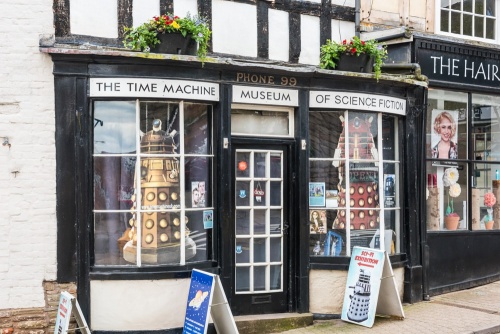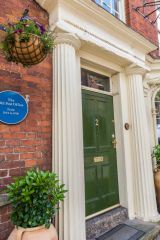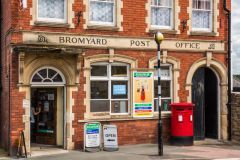
Bromyard is an attractive hilltop market town in eastern Herefordshire, about 13 miles northeast of Hereford. The town dates back to the 9th century and boasts a wonderful collection of historic buildings, many of them timber-framed.
The Domesday Book of 1086 recorded 42 villeins (villagers) in 'Bromgeard', making it one of the largest settlements in Herefordshire. Around 1125 Bromyard received permission to hold a regular fair.
Bromyard Grammar School was founded in 1566, and 90 years later in 1656 the wealthy goldsmith John Perrin, an Alderman of London and a native of Bromyard, bequeathed £20 a year to the school, to be administered by the Goldsmiths Company. The Goldsmiths Company administered the school for over 2 centuries.
The town suffered during the Civil War when Prince Rupert, leading the Royalist army, pillaged Bromyard and Ledbury and 'plundered every parish and house'.

The wealth of outstanding timber-framed shops and houses is a testament to the town's wealth throughout the late medieval period and into the 17th and 18th centuries. Many Georgian and Victorian shop fronts on Broad Street hide much older timber-framed buildings.
In more recent times the town's prosperity has been centred on the hop growing industry. People came from the Black Country and from South Wales to pick hops at local farms. For many people, this seasonal work served as their annual two-week 'holiday'.
Bromyard grew up in the valley of the River Frome close to the county boundary between Herefordshire and Worcestershire.
The town name comes from the Old English term for 'a thorny enclosure', or 'an area covered with gorse'. The 17th-century map-maker John Ogilvy called the Bromyard Downs an area of 'Furrs and Ferns'. Ogilvy would still recognise the town's layout, which has changed very little over the intervening centuries.

The Heritage Trail
Bromyard Heritage Centre
Your first port of call in Bromyard is the Heritage Centre complex on Rowberry Street, immediately beside the large visitor parking area. The Heritage Centre has a wealth of useful information on things to see and do in the Bromyard area, with maps, brochures and advice.
You can pick up a very useful leaflet at the Heritage Centre outlining a heritage trail that links historic buildings around Bromyard. The trail begins at the Heritage Centre complex at the top of Rowberry Street. From there stroll up Church Walk to the historic medieval parish church of St Peter.
St Peter's Church
The church we see today was built around 1160 but it stands on the foundations of a much older Saxon building built around AD 840. Look for a Saxon carved figure of St Peter over the south doorway.
The font is late Saxon or early Norman and is carved with chevrons and geometric patterns. At the west end of the north aisle is a 13th-century stone effigy of a knight, and nearby is the Bromyard Bushel, a 1670 cast iron bowl used as an official measure by local merchants.

Jackson's Almshouses
Almost directly opposite the Heritage Centre stands a set of almshouses built in 1656 for 'Poor Women of Good Character' and created by a bequest from Phineas Jackson, the vicar of St Peter's Church. The almshouses were laid out as 7 apartments around three sides of a central square.
The fourth side of the square is almost closed by outbuildings. The buildings stand two storeys high with an entrance on Cruxwell Street. The interiors (now inaccessible to visitors) boast an original timber-framed passage and a king-post roof.
A painted board over the doorway reads:
'Bromyard Non-ecclesiastical Charities
These almshouses were erected in the early Seventeenth Century and are provided for Poor Women of Good Character from the Ancient Township of Bromyard. In 1962, they were Modernised and the Original Seven houses were Converted into four flatlets'.

Walk up Cruxwell Street and turn left onto Broad Street, Bromyard's traditional main street. Walk up the street to the ...
Falcon Hotel
One of Bromyard's most picturesque buildings is the timber-framed Falcon Hotel at the corner of Broad Street and Pump Street. The Falcon is one of many coaching inns serving the mail coach service between Worcester Kington and Presteigne. This Grade II listed building dates to the 17th century but incorporates Elizabethan panelling from an earlier building on the site.

Tower Hill House
Take a short detour down Pump Street, cross the A44 and you will see Tower Hill House (sometimes known simply as 'Tower House'), another picturesque 'black and white' building. King Charles I is said to have stayed at Tower Hill House in March 1645 on his way to Hereford.
The house would have been quite modern at the time; it was built in 1630, a date that appears on a pendant under the gable. The house features beautiful decorative panelling around the gable and on moulded barge boards under the eaves.

Return to Broad Street and turn right. Enjoy the wide variety of independent shops lining the street until you come to the small Market Square. One side of the Square is occupied by the Grade II listed Hop Pole Hotel, dating to the 18th century, with an entrance portico supported on fluted Tuscan columns.
On the south side of the Market Square, almost opposite the Hop Pole, is the Time Machine Museum of Science Fiction. Though it occupies a historic building, the museum is more about the future than the past. It offers a wonderful mix of items used in the Dr Who TV series over the years, including costumes worn by the various actors who played the eponymous Doctor Who. The museum also boasts original Star Wars items including an R2D2 robot signed by actor Kenny Baker who played R2D2 in the popular films.

Across Sherford Street from the Time Machine Museum is the Bromyard Local History Centre, where you can learn about the history of Bromyard through changing exhibits covering everything from Morgan motorcars to the history of hops and hop picking.
Walk down Sherford Street, passing the Crown and Sceptre pub, built in the early 19th century. Just past the pub, you will come to the Congregational Church, another early 19th-century building, and the Old Police Station, originally the town lock-up and police station but now a private house. Almost opposite is Sherford House, an attractive late 18th-century house of red brick.
Petty Bridge Tollhouse
At the bottom of Sherford Street stay left and follow the A44 to where Petty Bridge crosses the River Frome. The three-arched bridge dates to 1810 and is built of stone rubble. Immediately past the bridge is Petty Bridge Tollhouse. For over 100 years from the 1750s to the 1870s a toll-keeper lived here and demanded a toll for travellers on the turnpike road to Worcester. The house is now a private dwelling.

Just outside Bromyard is the National Trust's Brockhampton Estate, 1700 acres of traditionally-managed woods and farmland. At the heart of the estate is Lower Brockhampton Manor, a picturesque 14th-century moated manor house reached through a timber-framed gatehouse.
About Bromyard
Address: A44,
Bromyard,
Herefordshire,
England
Attraction Type: Town
Location: At the junction of the A44 and A645 about 11 miles northeast of Hereford.
Website: Bromyard
Location map
OS: SO655550
Photo Credit: David Ross and Britain Express
HERITAGE
 We've 'tagged' this attraction information to help you find related historic attractions and learn more about major time periods mentioned.
We've 'tagged' this attraction information to help you find related historic attractions and learn more about major time periods mentioned.
Find other attractions tagged with:
NEARBY HISTORIC ATTRACTIONS
Heritage Rated from 1- 5 (low to exceptional) on historic interest
Bromyard, St Peter's Church - 0.2 miles (Historic Church) ![]()
The Time Machine Museum of Science Fiction - 0.2 miles (Museum) ![]()
Bromyard Local History Centre - 0.3 miles (Museum) ![]()
Edwyn Ralph, St Michael Church - 1.7 miles (Historic Church) ![]()
Brockhampton Estate - 1.8 miles (Historic Building) ![]()
Edvin Loach Old Church - 2.1 miles (Historic Church) ![]()
Acton Beauchamp, St Giles Church - 3.3 miles (Historic Church) ![]()
Thornbury, St Anna's Church - 3.4 miles (Historic Church) ![]()
Nearest Holiday Cottages to Bromyard:
Bishops Frome, Herefordshire
Sleeps: 10
Stay from: £651 - 3313
More self catering near Bromyard













